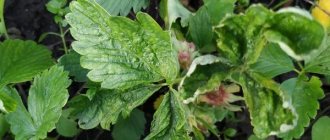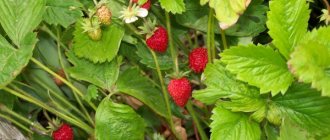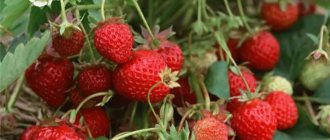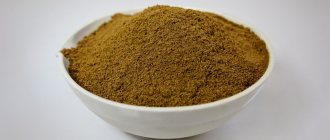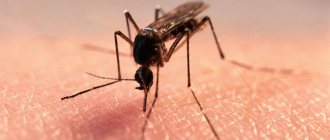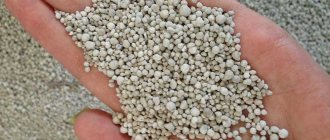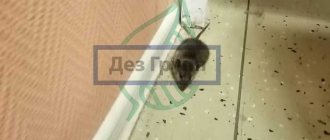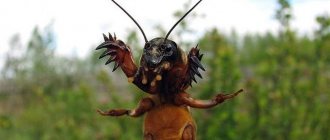When planting strawberries, it is worth putting fertilizer in the hole to stimulate growth and fruiting.
This is what will help you get a rich harvest even on a small plot, since you can grow high-quality berries if you know the basic rules and techniques of agricultural technology. Dear readers!
For you, we have created communities on social networks in which useful articles and interesting ideas are published several times a day! Subscribe and receive useful content in a convenient format! The most important thing is the correct process of planting bushes in open ground. We’ll talk about planting berries, as well as what to put in the hole, in today’s article.
What soil does strawberry like?
Garden strawberries are a fairly unpretentious plant and can grow in any soil. It is important to remember that the size and taste of the crop depends on the quality of the soil.
Small, sour or watery berries ripen in unsuitable conditions. Strawberries grow and bear fruit well on loamy and sandy soil. Such soil is breathable, does not retain excess moisture, and contains an optimal set of nutrients and macroelements. There are soil types that are not suitable for growing strawberries.
- Clay is a moisture-retaining substrate that does not allow sufficient oxygen to pass through, with low protection from temperature changes.
- Sandy - rapid drying, strong heating in the sun and nutritional deficiency.
- Peat - has a composition of nutrients that inhibit the development and fruit formation of berries.
Large and sweet berries ripen on moisture-intensive, breathable soil with neutral acidity.
Potassium value
You can significantly increase the stress resistance of young garden strawberry bushes using mineral complex potassium fertilizer. This microelement is extremely necessary for plants throughout the growing season, and especially in the fall, when crops are preparing for the upcoming cold weather.
Potassium performs the following functions:
- has a beneficial effect on the root system, contributing to its rapid strengthening and adaptation to a new location;
- activates the accumulation of a sufficient amount of sugars in the tissues of garden crops, which significantly increases its frost resistance;
- increases the immunity of the berry plant against infectious and fungal diseases.
Important!
Potassium chloride should not be used in autumn.
If this is the only thing you have on hand, you must adhere to the timing of its application - no earlier than three weeks before planting young bushes. During this time, most of the aggressive chlorine will have time to evaporate or erode and will not cause significant harm to garden vegetation. A wide range of potassium-containing fertilizers is presented on the website of the Agro-Center online store. Be sure to pay attention to the composition of the fertilizer - nitrogen should not be present in mixtures for autumn use.
Potassium humate is an ideal option
This universal fertilizer can protect capricious garden crops from all possible stress factors, so experienced gardeners recommend using it both in early spring and autumn. The use of potassium humate for strawberries before planting is due to the following reasons:
- the nutritional composition activates the formation of a powerful and hardy root system;
- takes an active part in planting the future harvest;
- has a beneficial effect on the quality of fruits, increasing their sugar content and enriching the vitamin composition.
Methods of application
Fertilizer is used in different ways. When planting young berry bushes in the fall, gardeners recommend soaking the root system of the crop in a solution of potassium humate for 10–15 hours. During this time, the roots will absorb the optimal amount of nutrients for them, which will allow the plant to adapt as quickly as possible to the new place.
The second option is watering at the root. In this case, potassium humate performs two tasks simultaneously: it strengthens the plant, saturating the soil with nutrients for future use, and improves the structure of the soil, making it looser, more air- and moisture-permeable.
Note! There are different types of potassium humates, which differ in composition and concentration of the active substance. Therefore, it is necessary to make a working solution of mineral fertilizer in strict accordance with the manufacturer’s instructions.
What do you put in the hole when you replant strawberries?
Before planting, to speed up establishment, it is recommended to place complex fertilizer in the planting hole. If planting bushes is planned for spring, it is better to prepare the bed in the fall.
For each square meter of area it is necessary to add 5-7 kg of ready-made humus, 30 g of potassium sulfate and a glass of ash.
Immediately before planting, a mixture of potassium sulfate and superphosphate (25 g of each per 1 m2) is placed in the hole.
ON A NOTE. A good option for planting strawberries in high beds is a mixture of garden soil and peat, to which dolomite flour and wood ash are added.
Rules
Here's what to consider:
- Fertilize only after fruiting!
- It is better to use complex fertilizers.
- The complexes must be applied immediately after preparation, and not after a few days!
- In November, it is better to combine fertilizing with mulching.
- In autumn, it is better not to use fertilizers that contain nitrogen-containing compounds.
By following these instructions, you can get a good strawberry harvest!
How to disinfect soil
To obtain a healthy, abundantly fruiting bush, it is necessary to protect it from possible diseases and pests.
Soil disinfection is a simple but effective manipulation. The procedure is carried out immediately before planting strawberries. There are several methods of disinfection:
- Artificial heating of the substrate to high temperatures, destroying bacteria and pest larvae. There are two available methods: pour a sufficient amount of boiling water over the garden bed; cover with several layers of polyethylene for 2 - 3 sunny days.
- Folk remedies are used in organic farming. Infusions of pine needles, tobacco, and wormwood have bactericidal properties.
- Use of microorganisms. EM - preparations containing beneficial strains of bacteria help destroy or displace pathogens from the garden bed.
- Treatment with pesticides is an effective and fast-acting protection. However, along with harmful bacteria, the beneficial microflora of the soil is destroyed, and chemicals accumulate in the soil and strawberry tissues.
GOOD TO KNOW . It is better to plant strawberry tendrils in a new place, which also prevents the spread of diseases.
In what cases is it necessary to deoxidize the soil for strawberries?
Strawberries prefer to grow in a neutral or slightly alkaline environment. Increased acidity suppresses the vital activity of beneficial microorganisms and interferes with the effective absorption of microelements.
Bushes on such land respond poorly to fertilization, and the berries ripen small and not sweet. Summer residents deoxidize the soil using substances:
- Lime . It is applied in the fall, after which the area needs to be dug up.
- Dolomite flour . Can be applied in the spring, immediately before planting bushes. Dolomite also loosens heavy clay soils and is useful for controlling wireworms.
- Wood ash . Effectively deoxidizes and fertilizes the soil.
- Gypsum . “Long-lasting” deoxidizer. After a one-time application it will work with every acidity failure.
- Chalk . It is advisable to apply in crushed form before winter.
What fertilizers can be placed in the hole when planting strawberries?
The type and quantity of fertilizers that should be placed in the planting hole depend on the quality of the soil. It is recommended to add 1 bucket of rotted manure and 2 cups of wood ash to a bucket of garden soil to the area where the holes are planned. The following preparations are used for feeding:
- Ammonium sulfate . The solution is prepared at the rate of 1 tbsp. drug per 10 liters of water.
- Potassium humate . It is applied to the beds before mulching with peat, straw or humus.
- Superphosphate . It is advisable to add it in advance so that the substance has time to dissolve well.
- Growth stimulants.
- Ammofoska . It is highly soluble in water, does not contain nitrates, and is a complex product.
- Ammonium nitrate . The solution is used to water the entire area prepared for planting.
ON A NOTE. After planting, the berries are fed every six months. If necessary, additional fertilizer can be applied in mid-summer.
It is recommended to pour a layer of sand at the bottom of the planting hole. Pour the prepared soil mixture on top. If bird droppings are spread between the rows, the plants will be provided with organic nitrogen and protection from weeds.
Optimal planting dates
Autumn planting of a bed of young strawberries should be carried out from the end of July and completed before mid-September. By this time, the berries have been collected, and the plants begin to actively grow their root system. In addition, from the moment the preparatory work on organizing the plantation begins and until the actual planting of the strawberry bushes, at least a month will pass.
During this time, the prepared soil substrate will sag and become compacted, which will allow the young plant to be securely fixed in it.
By the time stable cold weather sets in, when the berry plant is preparing to hibernate, the plants will have a well-formed root system, a stronger structure and fruit buds have been formed. Even if late varieties of strawberries are planted, all preparatory agrotechnical work should be completed a month before the onset of the first cold weather.
What organic fertilizers can be added to the hole when planting strawberries?
Organic fertilizers for planting and growing strawberries are considered the most beneficial for the plant and the soil. It is recommended to put the following in the hole:
- Cow or horse manure The droppings of poultry have proven themselves well. To apply directly under the roots, the manure must be well rotted. Fresh manure can be spread between the rows, sprinkled with a little soil.
- Peat is applied to poor clay or sandy soils. Peat in its pure form is used for mulching bushes.
- Humus can be used from any origin for rapid plant development. Rotted organic remains from compost pits serve as a good source of nutrition and protection from negative environmental factors. It helps loosen the soil, increasing permeability to air and water.
- Sapropel , bottom sediment in lakes, has a composition rich in microelements, vermicompost, and minerals. Has antibacterial properties.
- Bone meal is a rich source of microelements for soil enrichment.
If you put organic matter in the hole, it speeds up the development of the berry and fruiting. Thanks to good feeding, the strawberry bush grows healthy and strong.
What folk fertilizers can be used
Over the history of plant growing, traditions have developed in plant nutrition. Folk methods for increasing productivity are passed down from generation to generation. Such products do not require a lot of costs and are safe for the environment.
Onion peel
Onions are famous for their bactericidal properties and vitamin and mineral complex. Onion peels contain many elements necessary for plant development.
To prepare the nutrient, you need to pour boiling water over a handful of husks and leave for 24 hours. A good solution has a rich brown color. It is added to water for irrigation.
Eggshell
Egg shells contain more than 20 different micro and macroelements. The crushed shells are poured with water and left for 10-14 days until cloudy. When applying, the resulting concentrate is diluted with water in a ratio of 1:10.
IMPORTANT. It is better to use shells from fresh eggs.
Bird droppings
An infusion of poultry droppings is not suitable for all crops, but for strawberries it is an effective fertilizer. Leave the dung filled with water for 2-5 days. The mixture needs regular stirring. Before use, it is diluted in a ratio of 1:15.
Nutritional yeast
Baker's yeast is a storehouse of useful substances and microorganisms. Fertilize strawberries with dough made from yeast and sugar. The finished mixture is diluted in water and the plants are watered as usual.
What is better to put in the hole when planting strawberries in the spring?
Strawberries can be planted in early autumn or spring. Depending on the time of planting, the composition of nutrients that are placed in the hole depends. In spring, preference is given to fertilizers that accelerate the rooting and growth of the plant.
The area should be cleared of weeds and well dug with humus added. Young bushes are planted in a previously prepared bed at a distance of 40 cm. Ash, compost and complex mineral fertilizer are added to the hole. You can treat the bushes with a growth activator.
Signs of lack or excess of minerals in strawberries
You can find out that this plant lacks some macro or microelements by its foliage - it changes its color. Signs of such a deficiency are as follows:
- when there is a lack of nitrogen, the foliage becomes paler in color, may turn yellow, its growth slows down, and as a result, it falls off prematurely. The leaf blades quickly turn yellow, but the veins remain green. But the color of the foliage can turn purple with a reddish tint;
- A lack of phosphorus primarily affects ripening berries - they lose their taste and become too soft. And the leaves acquire a dark brown color, which worsens in cold, dry times;
- with potassium deficiency, the lower leaves of the plant are the first to suffer - the edges of the leaves begin to turn red, and over time the color of the entire leaf plate changes;
- With calcium deficiency, young leaves do not unfold and their tips begin to darken.
Excess of mineral fertilizers is also harmful and is expressed in an overly saturated color of the leaf blades of strawberries, interveinal chlorosis may appear, and the growth of the above-ground and underground parts of the bushes slows down. Yellowing of the leaf edges may also occur.
Common mistakes
When planting strawberries, inexperienced gardeners may make mistakes that can lead to illness or death of the berries. You can save the plantation by knowing about them.
- Choosing a variety that does not correspond to the climatic conditions of the region.
- Long-term, more than 5 years, cultivation of plants in one place.
- Deepening the growth point of the bush.
- Untimely mustache trimming.
- Use dense, poor soil.
- Shading plantings with strawberries.
- Insufficient watering during berry ripening.
By eliminating unfavorable factors in the life of the plant, a significant increase in yield can be achieved.
Answers to frequently asked questions
Gardeners often have questions when growing strawberries in their garden plots. They concern all stages of strawberry development, from planting to harvesting. Some of them:
Where is the best place to buy seedlings?
If you grow varietal strawberries with the appropriate characteristics, it is better to purchase seedlings from specialized nurseries.
How often to water the mustache after planting?
Strawberries should be planted in well-soaked soil. Then water daily for a week until complete rooting.
What is the best way to cover beds for the winter?
To protect the roots from freezing, it is recommended to cover the plantings with pine or spruce branches.
When replanting a bush, do you need to remove old leaves?
All old leaves must be carefully removed, as they contain a large number of pests and pathogens.
Is it worth cutting the roots of seedlings?
Before planting, it is recommended to trim the roots of strawberries at a right angle of 1-2 cm.
Autumn care and preparation for winter
As soon as the last harvest is harvested, the crop has fully bear fruit, the berry needs help and support. An experienced gardener does not forget about the mandatory autumn care of strawberries in order to prepare the bushes for winter and the new season.
Closer to autumn and at the very beginning of September, the temperature drops and the humidity rises. There is a danger of fungal infections:
- fungal leaf spot;
- brown spot;
- black root rot;
- white spotting;
- withering.
For eradication treatments and protection of strawberries from diseases, the simplest and most inexpensive preparations are used:
- Fitosporin-M;
- Bordeaux mixture;
- Radomil;
- Topaz;
- copper sulfate.
Brown, unsightly spots are signs of brown spot (the most common cases of infection). The leaves quickly dry out and die. Any spotting disrupts photosynthesis processes and weakens the plant. The main rule is not to miss the moment of “no return”, when the entire plantation is affected by the fungus and the entire berry garden will have to be cleaned out.
Do I need to cut off strawberry leaves for the winter or not?
If the plantings are healthy, the varieties grow resistant, the berry garden is updated in a timely manner, then there is no need to remove the leaves . Strawberries will again have to spend a lot of effort to grow a thick cover of leaves.
If infection begins, fungal spores spread throughout the planting, and the leaves begin to die off rapidly, then it is better to cut off the entire above-ground part in the fall and burn it, and spray the ridges with eradicating solutions.
Important: cut leaves are used for humus or for making compost (for at least 2 years). Then all pathogenic fungi will die.
In the fall, a thorough inspection and cleaning of garden strawberry bushes is carried out in order to prevent strawberry mites:
- weakened, damaged vegetative parts are discarded;
- dispose of rotten, dry berries, dry leaves;
- remove old spent peduncles.
